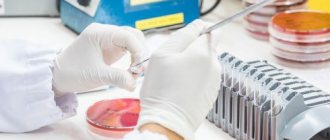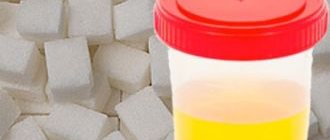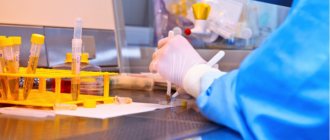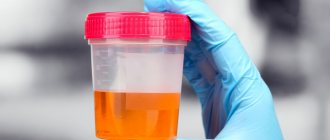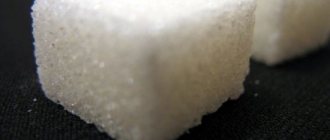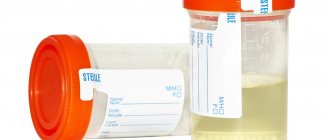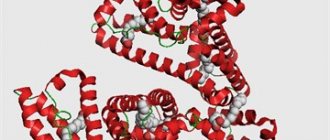A urine sugar strip test is a convenient method that helps you monitor your glucose levels without going to the doctor. Such testing helps to detect diabetes early and seek medical help in time. Test strips are also regularly used by people with metabolic disorders who are at risk.
Urine sugar strips may not give accurate percentage results. They only help to understand whether further examination is needed and whether there are problems with insulin production. To prescribe treatment and determine the extent of the disease, a laboratory test of blood and urine is performed, and a glucometer test is performed.
What are they?
Test strips allow you to find out how much sugar is contained in urine. They are used by diabetics and healthy people when glycosuria is suspected. With their help, it is possible to obtain an express result that will be quite accurate if the rules of use are followed.
They are used both at home and in clinics. There are a large number of different tests available on the market. The differences between the products for testing are in the following aspects:
- amount in a package;
- the range in which the strip operates;
- time of the test.
To choose the right product for analysis, you need to pay attention to the characteristics and carefully study the description of each product.
Important! To obtain an accurate result, you must carefully study the instructions for use. Regardless of the manufacturer, all options are used approximately the same.
What are test strips
A urine test strip (“dry chemistry”) is an indicator of the presence of biochemical substances. They are produced in the form of oblong pieces of paper or plates, with a reagent applied to the surface that changes color in the presence of a specific compound.
In most cases, test strips for urine analysis are used when a patient first visits the hospital. They are indispensable for mass preventive examinations, assessment of the severity of a person’s condition by an ambulance doctor, and self-monitoring in the presence of chronic pathology of the urinary system, liver and endocrine organs.
How to use
Using strips correctly is not difficult. To carry out the measurement you will need to perform the following steps:
- Prepare a sterile container for urine. It is advisable to use pharmacy options.
- Collect material for testing. Depending on the type of study chosen (daily, one-time), it is necessary to collect urine. Before doing this, you need to carry out hygiene procedures. During the daily collection, the first urination is into the toilet. After this, urine is collected in a special container during the day. For one-time use, you need to urinate partly into the toilet, partly into a small jar.
- Open the package and remove one strip. The indicator element will need to be placed in the urine for 2-3 seconds.
- Remove and place the product on a dry surface and wait for the result.
To carry out the analysis, you can use a special urine jar
Reaction time is 1-2 minutes. The result is deciphered immediately after the strip changes its color. It is important to remember that once the product is removed for analysis, it must be used within 60 minutes. Do not hold the product by the indicator. All actions during the test must strictly follow the official instructions. To perform a rapid test, you can urinate directly onto the strip.
The result is determined using a glucose scale. It can be located inside the box. The colors of the scale depend on the strip manufacturer. As a rule, yellow is negative (norm - no glucose in the urine), and green is positive. If the indicator element begins to turn green, this means that the urine contains glucose.
Using test strips
A quick urine test for sugar is carried out using test strips. The indicator is lowered into the container with urine. You need to know how to properly view the result in 1-2 minutes.
The color of the strip is checked against the scale printed on the packaging. Sugar level values depend on the color of the indicator:
- The absence of sugar in the urine or glu negative corresponds to the first division on the scale.
- A mark of 1+ means that serum glucose exceeds 180 mg/dL and urine glucose is 250 mg/deciliter or 11.1 mmol/L. Detection of traces of glucose corresponds to 100 mg/dL or 5.55 mmol/L.
- An indicator of 2+ indicates more than 500 mg/dL or 27.75 sugar in the urine, and more than 200 mg/dL in the blood.
- Test 3+ is associated with an increase in glucose to 1000 mg/dL or 55.5 mmol/L in the urine and above, and in the blood the level will reach 300 mg/dL.
- A reading of 4+ indicates that glucose is above 400 mg/dL in the blood and about 2000 mg/dL or 111 mmol/L in the urine.
The rules for collecting urine for sugar are the same - the material is collected in a sterile container and stored for no more than 1.5 hours. A rapid test is performed before submitting urine for daily diuresis.
Glucosuria entails excess urinary water loss, osmotic diuresis, and the risk of dehydration.
The consequences of low blood sugar are varied:
- weakening of muscles without a source of energy;
- kidney dysfunction and inflammation.
Glucose and protein tests are important for diagnosing kidney failure. Timely collection of urine for sugar prevents the development of exacerbations.
Most popular options
The most popular strips for urine analysis are express options called:
- Biosensor Uriglyuk;
- Bioscan Glucose;
- Glucofan.
The differences between each of them are the price, measurement time and other small details. The most cost-effective is Biosensor Uriglyuk. Glucofan is better suited for daily control.
One of the most popular options on the market
Before making a final choice in favor of any product, you should consult your doctor. He will select the most optimal option. Products for analysis must be purchased exclusively from pharmacies. Sometimes doctors recommend purchasing strips along with them to detect acetone in urine.
To buy a quality product, you need to carefully study all the available options. Urine glucose test strips are easy to use. With their help, diabetics and people who are at risk of diabetes can monitor their glucose levels.
Types of test strips
You can buy the kit at most pharmacies. But you need to choose strips only under the supervision of a doctor, otherwise you will waste a considerable amount of money.
High-quality test strips (they are also called “strips”) have the following trade names:
- "Uriscan" (South Korea);
- "Stix" and "Analyticon" (Germany);
- “Self-test”, “Uristik” (China);
- "Citolab" (Ukraine);
- Multicheck (Canada);
- "UrineRS" (USA);
- "Bioscan", "Uripolian" (Russia).
Each company has a different range of diagnostic products. For example, Uriscan test strips determine from 1 to 11 indicators. But their unauthorized use is simply impractical. Remember that for any study there must be a direct indication.
Carrying out analysis
Determining sugar in urine using test strips takes place in several stages:
- Urine is collected in a clean and dry container.
- The strip is immersed in it on the side where the applied reagents are located.
- Remaining liquid is removed using filter paper.
- The result is assessed in a minute. To do this, the resulting color is compared with the sample on the packaging.
Urine containing large quantities of sediment requires five minutes of centrifugation.
The result should not be analyzed before one minute has elapsed, as it may be underestimated.
Also, you should not wait more than 2 minutes, as this may cause the indicators to exceed.
Test strips are used to determine sugar in urine:
- For analysis of 24-hour urine.
- To determine glucose in half-hour portions (analysis can be performed at any time).
To find out the sugar content in a half-hour portion of urine, you need to perform a number of steps:
- Empty your bladder.
- Drink about 200 milliliters of water.
- Wait 30 minutes and collect the urine to determine the sugar in it.
A result of up to 2% indicates a glucose level of less than 15 mmol/l.
Using test strips
To determine sugar in urine, special Glucotest strips are used. The package can contain 25, 50 or 100 test strips.
In order for the test results to be reliable, it is necessary to monitor the period and storage conditions of the strips.
They must be kept in a small container made of plastic. It contains a desiccant necessary to absorb moisture that enters the container when it is opened.
A urine test using Glucotest is done as follows:
- Moisten the indicator zone of the strip with urine.
- Wait 2 minutes.
- Compare the result obtained with the scale on the package.
In a healthy person, glucose is normally absent in urine and cannot be determined using conventional laboratory methods. Therefore, the Glucotest test strip does not change color.
The appearance of sugar in the urine - glucosuria - is associated with an excess of its concentration in the blood.
Since glucose in the urine is considered a threshold substance, it is detected when the renal threshold in the blood is exceeded (over 8-10 mmol/l).
The price of test strips depends on the number of pieces in the package and the manufacturer. It usually starts from 100 rubles and for 50 pieces it is about 150-200 rubles.
At the clinic, you can find out the sugar levels in your urine using the “Pyokotest”.
Test strips allow patients to monitor their body sugar levels at home. Sold without a prescription by pharmacy chains, the packaging comes with instructions and an indicator scale for deciphering the results. The indicator is 99% accurate if storage conditions and rules of use are followed. The indicator layer on the strip can consist of different reagents, it all depends on the manufacturing company. The color of the indicator changes depending on the presence of glucose in the urine. The maximum sugar level that the strips measure is 112 mmol/liter.
Test strips allow patients to monitor their sugar levels at home
Types of glucose test strips, prices:
- Glucofan. Manufacturer: Czech pharmaceutical company. The accuracy of the analysis does not depend on the presence of acetone or acidity. The package contains 50 strips, the indicator scale is on the tube. Cost – 200 rubles;
- Auction Sticks. . The strips are suitable for simple analysis using a laboratory analyzer. The package contains 100 strips measuring glucose, bilirubin, acetone, blood, pH, leukocytes, nitrites. The package costs 1949 rubles;
- Dirui H13-Cr. The strips are used for manual and automatic analysis of sugar, ketones, bilirubin, nitrites, leukocytes, occult blood, ascorbic acid. For 100 strips the price is 970 rubles;
- UrineRS A10. The strips measure, in addition to the level of glucose in the urine, 9 more important parameters (pH, acetone, hemoglobin, etc.). For 100 tests you need to pay 683 rubles;
- MultiCheck. Analogue of Multistix strips. The test measures over 10 parameters, including glucose. 100 pieces. cost 750 rubles;
- Uristik-Dirui A10. An adequate analogue of expensive foreign Multistix tests. Used in analyzers and at home. More than 10 indicators are measured, including sugar. For 100 pcs. you need to pay 770 rubles;
- Multistix. . Expensive tests that determine the amount of glucose in the urine, protein, pH level, acetone, nitrites and white blood cells. Can be used for manual checks and with an analyzer. For 100 pcs. you need to pay 1950 rubles;
- Decafan Laura. . Measures 10 indicators. A pack of 100 strips costs RUB 1,599;
- Decafan Leiko. . Measures sugar, urine nitrites, protein and bilirubin, red blood cells. For 100 strips you need to pay 1265 rubles, a pack of 50 tests costs 831 rubles;
- Betacek. Tests from an Australian manufacturer for calculating the amount of sugar from 1 to 55 mmol/l. 50 strips cost 599 rubles;
- Bioscan. 50 strips for analyzing urine for sugar are hermetically stored inside a metal tube. Packaging costs 115 rubles. The products of the Russian manufacturer are an adequate replacement for Czech Glucofan strips. Bioscan tests for calculating glucose and acetone cost 155 rubles. for 50 pcs.;
- Bioscan Penta. Tests from a Russian manufacturer for urine analysis at home and in the laboratory for 5 parameters including glucose. A metal tube with 50 strips costs 310 rubles;
- Uriglyuk. Tests from are used at home and in laboratories. 50 strips cost 170 rubles;
- Diaglyuk. Tests from are intended for tentative detection of glucose levels in diabetic patients at home and in the laboratory. For 50 strips you need to pay 299 rubles;
- Uripolian-11. The strips detect 11 urine parameters, including glucose. 100 pieces. cost 750 rub. A package containing 50 strips costs 675 rubles.
How to test for sugar in urine
To detect sugar in urine, you will need Glucotest test strips, which can be purchased at any pharmacy or ordered from an online store.
- Urine is collected in a clean and dry container.
- The test strip should be immersed in the urine with the end on which the reagents are applied.
- Using filter paper, you need to remove any remaining urine.
- After 60 seconds, you can evaluate the result of a urine test for sugar. On the test strip, the reagent is colored in a specific color, which must be compared with the data. Indicated on the packaging.
If the urine has a large sediment, you need to centrifuge for five minutes.
It is necessary to evaluate the indicators only a minute after applying urine to the reagents, otherwise the data may turn out to be much lower than the true ones. In particular, you should not wait longer than two minutes.
Since in this case the indicator will be overestimated.
Test strips can be used to detect sugar in urine:
When identifying indicators in daily urine; When performing an analysis for sugar in a half-hour portion.
When conducting a test for glucose levels in half-hour urine, you need to:
Clinical pictureAccording to Decree No. 56742, every diabetic can receive a unique remedy at a special price! Doctor of Medical Sciences, head of the Institute of Diabetology Tatyana Yakovleva
I have been studying the problem of DIABETES for many years. It's scary when so many people die and even more become disabled due to diabetes.
I hasten to report good news - the Endocrinological Research Center of the Russian Academy of Medical Sciences managed to develop a medicine that completely cures diabetes mellitus. At the moment, the effectiveness of this drug is approaching 100%.
Another good news: the Ministry of Health has achieved the adoption of a special program under which the entire cost of the drug is compensated. In Russia and the CIS countries, diabetics up to
On July 6th they can receive the product -
FREE!
Find out more>>
- Empty your bladder;
- Drink 200 ml of liquid;
- After half an hour, collect urine to identify sugar in it.
Expert opinionGuseva Yulia AlexandrovaSpecialized endocrinologist
If the result is 2 percent or less, this indicates the presence of sugar in the urine in an amount of less than 15 mmol/liter.
How to use test strips
Vizox is a natural remedy based on native plant extracts. Read more Test strips are sold at the pharmacy in packs of 25, 50 and 100 pieces. Their cost is 100-200 rubles, depending on the number of test plates. When purchasing, you need to pay attention to the expiration date of the product.
It is also important to follow the rules for storing them so that the test results are reliable. The maximum shelf life of test strips after opening the package is no more than a month.
The glucotest must be stored in a plastic container that has a special desiccant that allows it to absorb moisture when any liquid enters the container. The packaging must be kept in a dark and dry place.
To conduct a test using Glucotest, you must:
- Dip the indicator zone of the test strip into the urine and remove it after a few seconds.
- After one or two minutes, the reagents will turn the desired color.
- After this, you need to compare the results obtained with the data indicated on the packaging.
If a person is completely healthy and the level of sugar in the urine does not exceed the norm, the test strips will not change color.
The advantage of test strips is their convenience and ease of use. Due to their small size, test strips can be taken with you and tested anywhere if necessary. Thus, you can test your urine for sugar levels in your urine when going on a long trip, and do not depend on doctors.
One of the big advantages is the fact that patients do not need to go to a clinic to test sugar in their urine. The study can be carried out at home.
This urine glucose detection tool is ideal for those who need to regularly monitor urine and blood sugar.
Glycemic profile for diabetes I was 130 kg now 65! I gained 17 kg of fat per week without dieting or training! I drank cheap bitters.. Fat belly is not from food! It will burn off in 3 days, drink strong Soviet one on an empty stomach.. Easy weight loss is available to everyone! Regular fat burns.. Age-related fat does not come from food! It will go away in 3 days, drink regular Soviet one on an empty stomach...
Urine testing for diabetes should be done systematically. Thus, you can monitor all changes in the kidneys and other internal organs.
When examining urine, hyperglycemia can be detected, which accompanies diabetes mellitus. If you have such a disease, you should check the presence of protein and acetone in your urine every six months.
In addition, a urine test for sugar allows you to detect disorders in the genitourinary system and identify how metabolic processes occur in the patient’s body. Indeed, according to statistics, 45% of diabetics have kidney problems.
When glycemic levels increase, the kidneys cannot retain excess sugar, which is why it ends up in urine. At the same time, 1 g of dissolved sugar in the urine removes about 14 g of liquid from the body, as a result of which a person experiences thirst, as he needs to restore his water balance. The more sugar is excreted in the urine, the stronger the thirst will be, and the cells will not receive the necessary vital energy.
Application of test strips
Disposable strips for determining sugar in urine operate on the basis of an enzymatic reaction (peroxidase, glucose oxidase), during which the color of the sensor, that is, the indicator field, changes.
The glucose test strip can be used in both medical and home settings. They are used to detect sugar levels in the urine of children and adults with diabetes and other metabolic disorders.
Using the pyocotest, you can determine the amount of glucose in urine, control the level of glycemia, and adjust the diet and treatment process. You can also get similar benefits by doing a glucose test or using Uriscan paper strips.
However, it is worth knowing that this method for detecting glucosuria gives approximate results. But in this way it is convenient to analyze urine for diabetes mellitus in children, which allows you to avoid puncturing your finger. Although, to obtain the most accurate result, it is still necessary to use a glucotest to measure blood sugar levels or use a glucometer.
To decipher the results of a urine glucose test to be reliable, it is not necessary to have special medical knowledge, but it is still worth following some rules. To begin with, you should know that to determine glucose in urine, you can use test strips of three forms - No. 25, 50, 100. They are packaged in a metal, plastic or glass tube.
It is worth noting that for type 2 diabetes, 50 strips are enough for the patient per month. Test strips, including Uriskan, are placed in a cardboard package that contains a tube with 50 strips and an insert.
Most strips have a yellow glucose sensor. However, its composition and components may be different.
The color of the paper changes depending on the concentration of sugar. If no glucose was detected, then the sensor hue remains yellow. When the urine is sweet, the indicator turns a dark blue-green color.
The maximum indicator of the presence of glucose in urine test strips shows 112 mmol/l. The results will be known within 1 minute after applying urine to the indicator.
However, the interpretation of the analysis for type 2 or 1 diabetes mellitus may be incorrect if:
- the container used to collect urine was poorly washed;
- the sample contains drugs;
- there is ascorbic or gentisic acid in the urine;
The presence of sugar in urine can be indicated by increased density of urine in diabetes mellitus, when 10 g/l of glucose increases the specific gravity of urine by 0.004. It is worth noting that there are special types of test strips that have a separate indicator that allows you to determine the specific gravity of urine. However, their price is quite high, so it is pointless to use them only for determining sugar in urine.
The cost of test strips can vary - from 115 to 1260 rubles.
Why do you need to test your urine if you have diabetes?
In addition to glucose, a test for sugar in urine can also identify kidney diseases, the presence of which is indicated by an increased protein content in urine.
This phenomenon is called microalbuminuria, which develops when albumin from the bloodstream enters the urine. If left untreated, protein leakage can lead to permanent renal failure.
Urine for diabetes mellitus should be tested every 6 months. After all, protein is not the only indicator that can be detected by passing urine tests. Thus, the results help to identify complications arising from type 1 and type 2 diabetes.
Moreover, testing evaluates the following indicators:
- physical characteristics (sediment, transparency, color);
- chemical properties (acidity);
- specific gravity of urine (determines how much the kidneys are able to concentrate urine);
- urine sediment (allows you to identify inflammation in the urinary system);
- ketone bodies, protein, sugar - an excess of these substances indicates metabolic disorders, and the presence of acetone indicates decompensation of diabetes, and this condition is accompanied by the taste of acetone in the mouth.
If necessary, an analysis is performed to determine the concentration of diastase in the urine. This enzyme is produced by the pancreas and also breaks down carbohydrates (starch). An increased concentration of diastase indicates the presence of pancreatitis.
How indicator strips work
The white becomes the color of the dye on the strip.
The test for protein in urine allows you to determine the qualitative and semi-quantitative content of protein in urine using the “dry chemistry” method based on the principle of pH indicators. An acid buffer and a special acid-base indicator (dye) are applied to the sensory area. When protein dissolved in urine hits the surface of the reagent zone, hydrogen ions from the dye are transferred to the protein, as a result of which the indicator changes its color. The higher the protein concentration, the more intense the reaction and coloring of the contact area.
Return to contents
